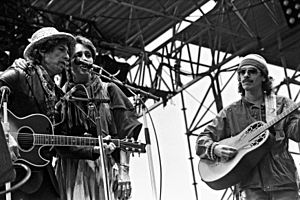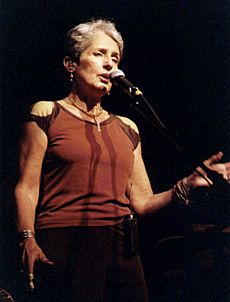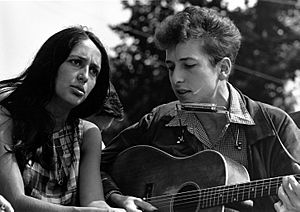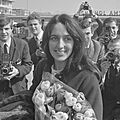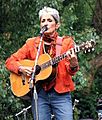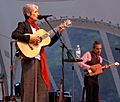Joan Baez facts for kids
Quick facts for kids
Joan Baez
|
|
|---|---|
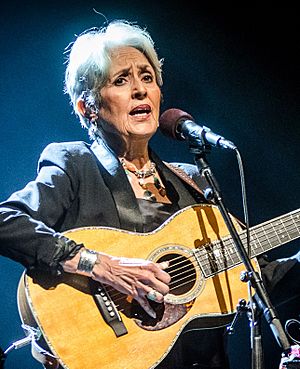
Baez in 2016
|
|
| Background information | |
| Birth name | Joan Chandos Baez |
| Born | January 9, 1941 Staten Island, New York, U.S. |
| Genres |
|
| Occupation(s) |
|
| Instruments |
|
| Years active | 1958–present |
| Labels |
|
Joan Chandos Baez (born January 9, 1941) is an American singer, songwriter, musician, and activist. She is famous for her powerful voice and for singing about important social issues. For over 60 years, she has used her music to call for peace and fairness. Her songs are often about protest and social justice.
Baez is known as a folk singer, but her music also includes folk rock, pop, country, and gospel music. She started her career in 1960 and quickly became a star. Her first three albums, Joan Baez, Joan Baez, Vol. 2, and Joan Baez in Concert, were all very successful and earned gold records.
While she writes her own songs, Baez is also famous for singing songs by other artists. She has performed songs by Bob Dylan, the Beatles, Leonard Cohen, and Stevie Wonder. In the early 1960s, she helped make Bob Dylan famous by singing his songs.
Some of her most famous songs include "Diamonds & Rust" and her version of "The Night They Drove Old Dixie Down". She is also known for singing "We Shall Overcome", which became an anthem for the Civil Rights Movement. Baez performed at the famous 1969 Woodstock Festival. Throughout her life, she has been a strong supporter of nonviolence, civil rights, human rights, and protecting the environment. In 2017, she was welcomed into the Rock and Roll Hall of Fame.
Contents
Early Life and Family
Joan Baez was born in Staten Island, New York City, on January 9, 1941. Her father, Albert Baez, was a physicist who was born in Mexico. Her mother, Joan Bridge, was born in Scotland. Joan was the second of three daughters. Her sisters, Pauline and Mimi, were also musicians and activists.
The Baez family became Quakers when Joan was a child. This faith shaped her strong belief in pacifism, which means opposing war and violence. Because of her Mexican heritage, she faced prejudice as a child. This experience inspired her to get involved with social causes early in her career.
Her father's work with UNESCO meant the family moved often. They lived in different parts of the United States and in other countries like England, France, and Spain. This gave Joan a view of the world that influenced her music and activism.
Music Career
Starting in Boston
When Joan was 13, she saw folk singer Pete Seeger in concert and was deeply inspired. She began learning his songs and performing them. In 1958, her family moved to the Boston area, which had a lively folk music scene. She started singing in local clubs while briefly attending Boston University.
In 1959, folk musician Bob Gibson invited Baez to perform with him at the Newport Folk Festival. Her amazing voice impressed the audience and critics. This performance launched her career and led to a record deal with Vanguard Records.
Breakthrough in the 1960s
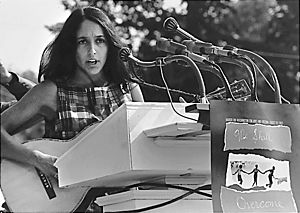
Baez's first album, Joan Baez (1960), was a collection of traditional folk songs, ballads, and blues. Her next albums, Joan Baez, Vol. 2 (1961) and Joan Baez in Concert (1962), were also huge successes. During this time, she became a leading figure in the American roots revival.
She introduced her audiences to a young songwriter named Bob Dylan. She often invited him on stage during her concerts, which helped his career take off. In 1962, Baez appeared on the cover of Time magazine, a rare honor for a musician at the time.
In the mid-1960s, she began to experiment with her music. She added more instruments and even worked with a classical music composer for albums like Noël (1966) and Joan (1967). In 1969, her performance at the Woodstock Festival made her an international star.
Career in the 1970s
In 1971, Baez released the album Blessed Are..., which included her hit cover of "The Night They Drove Old Dixie Down". This became one of her most popular songs. She then signed with A&M Records.
Her 1974 album, Gracias a la Vida, was sung entirely in Spanish and was a hit in the U.S. and Latin America. In 1975, she released Diamonds & Rust. The title song, about her relationship with Bob Dylan, became another one of her most famous works.
Later Career and Farewell Tour
Throughout the 1980s and 1990s, Baez continued to record music and tour the world. She performed at the 1985 Live Aid concert and on tours for Amnesty International, a human rights organization.
In 2008, she released the album Day After Tomorrow, which was produced by Steve Earle. It was her first album to make the charts in almost 30 years.
In 2018, she released her final studio album, Whistle Down the Wind. She then began her "Fare Thee Well Tour" to say goodbye to her fans. She retired from regular touring in 2019 but still performs at special events.
Activism and Social Causes
Social justice has always been as important to Baez as her music. She has said that it is the "true core of her life."
Civil Rights
In the 1950s, Baez heard Martin Luther King Jr. speak about nonviolence and civil rights. She was deeply moved and later became friends with him. She participated in many civil rights marches and demonstrations.
Her performance of "We Shall Overcome" at the 1963 March on Washington for Jobs and Freedom became a famous moment in the movement. The song became an anthem for people fighting for equality.
Vietnam War
Baez was a strong opponent of the Vietnam War. In 1964, she refused to pay 60% of her income taxes to protest the war. She also encouraged young men to resist being drafted into the army. She was arrested twice in 1967 for protesting at an army induction center and spent over a month in jail.
In 1972, she traveled to North Vietnam with a peace group. While she was in the city of Hanoi, it was bombed by the U.S. military for 11 straight days. This experience was documented in her song "Where Are You Now, My Son?".
Other Causes
Throughout her career, Baez has supported many other causes:
- Human Rights: She has worked closely with Amnesty International to fight for human rights around the world.
- LGBT Rights: She has performed at benefit concerts and marches to support the rights of gay and lesbian people.
- Environmentalism: She has supported environmental activists like Julia Butterfly Hill in their efforts to protect ancient redwood forests.
- Anti-War Protests: In 2003, she protested the U.S. invasion of Iraq.
Important Relationships
Bob Dylan
Baez met Bob Dylan in 1961. She was already a famous folk singer, and he was just starting out. She loved his songwriting and began performing his songs, which helped him become famous. They performed together at the Newport Folk Festival and toured together.
Their romantic relationship was intense but ended after a few years. Baez wrote several songs about Dylan, including the famous "Diamonds & Rust". They remained connected over the years and toured together again in the 1970s and 1980s.
David Harris
In 1967, Baez met David Harris, an anti-war activist, while they were both in jail for protesting. They married in 1968. Harris was later sent to prison for refusing to be drafted into the military.
While Harris was in prison, Baez performed at Woodstock while pregnant with their son, Gabriel. They divorced in 1973 but remained friends. Their son, Gabriel, is a drummer and sometimes tours with his mother.
Awards and Honors
Joan Baez has received many awards for her music and activism.
- In 2007, she received a Grammy Lifetime Achievement Award.
- In 2011, Amnesty International created the Joan Baez Award in her honor for her work in human rights.
- In 2017, she was inducted into the Rock and Roll Hall of Fame.
- In 2021, she received a Kennedy Center Honor, one of the highest awards for an artist in the United States.
- In 2023, Rolling Stone magazine ranked her at number 189 on its list of the 200 Greatest Singers of All Time.
Images for kids
-
Baez at Amsterdam Airport, 1966
-
Baez at the Hardly Strictly Bluegrass Festival 2005 at Golden Gate Park
-
Joan Baez concert in Dresden, Germany, July 2008
See also
 In Spanish: Joan Báez para niños
In Spanish: Joan Báez para niños
- List of peace activists



